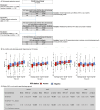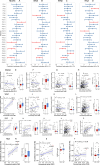Systemic biological mechanisms underpin poor post-discharge growth among severely wasted children with HIV
- PMID: 39604330
- PMCID: PMC11603168
- DOI: 10.1038/s41467-024-54717-w
Systemic biological mechanisms underpin poor post-discharge growth among severely wasted children with HIV
Abstract
In sub-Saharan Africa, children with severe malnutrition (SM) and HIV have substantially worse outcomes than children with SM alone, facing higher mortality risk and impaired nutritional recovery post-hospitalisation. Biological mechanisms underpinning this risk remain incompletely understood. This case-control study nested within the CHAIN cohort in Kenya, Uganda, Malawi, and Burkina Faso examined effect of HIV on six months post-discharge growth among children with SM and those at risk of malnutrition, assessed proteomic signatures associated with HIV in these children, and investigated how these systemic processes impact post-discharge growth in children with SM. Using SomaScanTM assay, 7335 human plasma proteins were quantified. Linear mixed models identified HIV-associated biological processes and their associations with post-discharge growth. Using structural equation modelling, we examined directed paths explaining how HIV influences post-discharge growth. Here, we show that at baseline, HIV is associated with lower anthropometry. Additionally, HIV is associated with protein profiles indicating increased complement activation and decreased insulin-like growth factor signalling and bone mineralisation. HIV indirectly affects post-discharge growth by influencing baseline anthropometry and modulating proteins involved in bone mineralisation and humoral immune responses. These findings suggest specific biological pathways linking HIV to poor growth, offering insights for targeted interventions in this vulnerable population.
© 2024. The Author(s).
Conflict of interest statement
Competing interests: The authors declare no competing interests.
Figures





References
-
- UNICEF, WHO & World Bank Group. Levels and trends in child malnutrition 2023: Estimates developed jointly by UNICEF, WHO and World Bank Group on child malnutritionhttps://www.who.int/data/gho/data/themes/topics/joint-child-malnutrition...
-
- UNAIDS. Global HIV & AIDS statistics — Fact sheet 2023 https://www.unaids.org/en/resources/factsheet#:~:text=Global%20HIV%20sta....
Publication types
MeSH terms
Substances
Grants and funding
LinkOut - more resources
Full Text Sources
Medical

